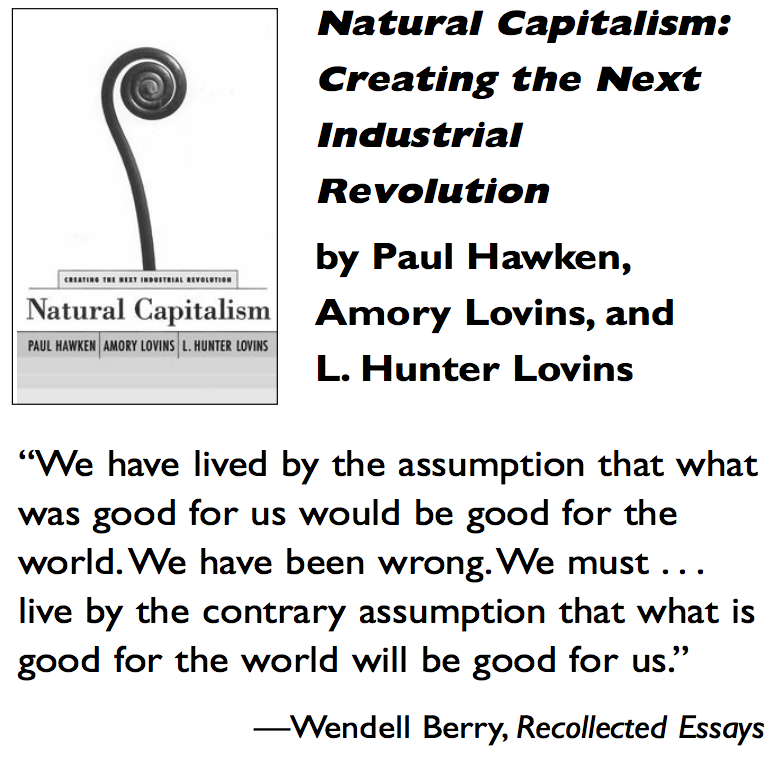All around us, we see and hear disturbing statistics about the damage that humans are inflicting on the environment. These statistics are often sad: percentage of rain forest acreage destroyed; number of species now extinct; size of the ozone hole.

But we hear less about the cost of environmental damage to human social life. To be sure, news about revolutions, internecine warfare, poverty, disease, and crime abounds. However, few of us explicitly make the connection between those human ills and the failing health of the living system that is Earth. Instead, we chalk up social hardships to a shortage of initiative, to laziness, to inevitable human aggression.
Natural Capitalism (Little, Brown, 1999) establishes the link between our attitudes toward the Earth’s bounty and our most challenging problems. As the authors explain, even Westerners can no longer ignore the mounting evidence that limits to our growth do exist and that those limits are fast approaching.
Still, many people struggle to accept that we must take action now to stave off complete biological and social breakdown. Why? Some of us feel hopeless. Others deny that a problem even exists. Yet others are with holding judgment until they can see proof that change can work. And many businesses assume that anything they do to help the environment must necessarily hurt their bottom line.
Natural Capitalism challenges all these attitudes and assumptions. The book not only takes a fresh look at capitalism, it also shows, through detailed examples and cases, that companies can be kind to the environment and profit more than ever.
A Reversal of Fortune
As the authors point out, businesses have focused on three kinds of capital: financial, or cash, investments, and monetary instruments; manufactured, including infrastructure, machines, tools, and factories; and human, the labor and intelligence, culture and organization that people bring to the workplace.
Natural capital the living systems, resources, and services (such as recycling carbon dioxide into oxygen) that our planet provides for free—hasn’t received as much emphasis, perhaps because it’s hard to attach a monetary value to it. Yet businesses use the other forms of capital to transform natural capital into the “stuff” of daily life: highways, cars, cities, bridges, houses, food, medicine, hospitals, schools.
In earlier times, financial, manufactured, and human capital were in relatively short supply compared with natural capital. Now, that ratio is reversed. Thus we must reverse our thinking.
The True Bottom Line
Natural capital makes up the true bottom line for any human endeavor. To boost it, we must attend to four interconnected principles:
- Radical resource productivity: using natural resources more effectively, so that what we get from, say, one kilo watt of electricity is far greater than what we used to get.
- Biomimicry: reducing wasteful and toxic through put of materials and, like nature, constantly reusing materials in closed cycles.
- Service and flow economy: shifting from an economy of goods and services to one of service and flow; for example, selling quality, utility, and performance, not objects.
- Investment in natural capital: sustaining, restoring, and expanding stocks of natural resources.
By outlining these principles, the book puts out a call to action. But it also holds out hope. As it turns out, numerous industries have already begun putting these principles into action—with remarkable results. For example:
- The automobile industry is slowly shifting from traditional car models to fuel-cell-powered vehicles that are lighter and safer, produce little pollution, cost consumers and producers less, and get up to 200 miles per gallon of gasoline.
- New, inexpensive-to-build houses designed with heat-trapping “super windows” remain cool even in 115 degree Fahrenheit temperatures without air conditioning—and warm even at–47 degrees—with no furnace.
- Innovative techniques for using wood fiber could supply all the paper and wood the world currently needs—from an area about the size of Iowa.
These and other examples in the book serve a vital purpose: They reveal that change is possible—and more profitable than even the most budget-minded business person could have dreamed.
Lauren Keller Johnson is a freelance writer living in Lincoln, MA.
